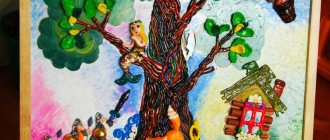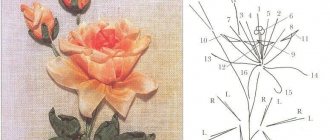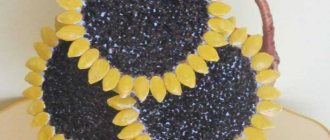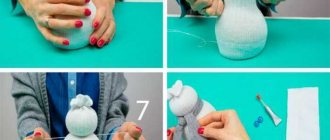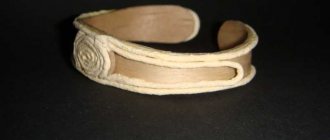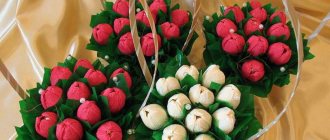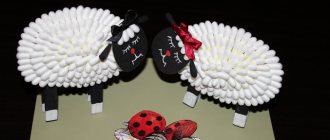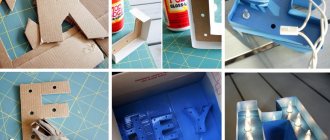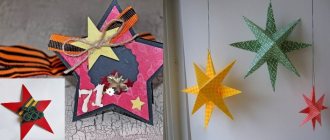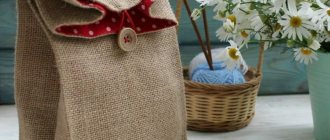Using a 3D pen, you can create works of art not only on paper, but in three-dimensional space. The work is based on 3D printers - creating a three-dimensional model in layers. The handles use plastic rods of different colors, materials: ABS and PLA plastic, polymer resins. You can use them to decorate objects, make a toy for a child, a decoration for yourself, and also use them in home decor. Thanks to paper layouts, drawing will become very simple.
Before you start, a couple of simple rules
The most common mistake among beginners is to start working on the frame when it is not strengthened. This model turns out to be too fragile and simply ends up breaking from its own weight. To prevent this from happening, strengthen the back side of the frame by painting it over its entire width. Which part it will be is up to you to choose.
You need to separate the paper from the frame, and not vice versa. If you act in the most obvious way, as it seems, and start peeling the craft off the sheet, it may break in the part that is most vulnerable to it. To prevent this, separate the paper from the plastic by lightly pressing one of your fingers on the model from the sheet side, and then everything will work out.
Don't forget about the ability to rotate the frame while working. It is not static and you can rotate it in any way that is convenient for you.
You should “paint” the frame carefully, moving in one direction, and not in a snake. If you started drawing strokes from the top on the right side, then continue to do so until you reach the left end of the model.
How to draw in 2 planes
3D pictures executed in two planes are very impressive. The illusion of volume is manifested by distorting the image at an angle to the fold line of the sheet and changing the proportions.
3d staircase
You will need fairly stiff paper or thin cardboard.
The sheet is unfolded into a vertical position, folded in half and a vertical line measuring 10 cm is drawn in the center. The pencil pressure should not be very strong. The drawn line is outlined with two horizontal stripes of 2 cm each.
The vertical 10 cm line is divided in the center by a horizontal 5 cm line, 2 cm on both sides.
Then curly lines alternately connect the resulting points (see the sequence in the photo).
Using a marker, draw the outline of the right half of the ladder. On the left side, draw the shadow of the crossbars and remove unnecessary details with an eraser. The jumpers on both sides must match.
Place the cardboard at an angle so that the ladder looks straight. The shadow will add volume to the drawing.
So, our image is almost ready. Now you need to bend the sheet of paper in half. Externally, the staircase will look like a real one.
Avoid mistakes
One of the most important rules of any instruction on how to make a craft from a 3D pen will say that you should not rush.
By quickly moving the device over the stencil of a piece of paper, plastic will begin to accumulate on the nozzle, creating a curved line instead of a straight line. Wait for the handle to warm up, press the feed button and slowly start working.
When connecting different parts of the frame, one or more colors, remember that you should not have empty space at the attachment points. It would seem like a small thing, but if this is not done, the model may fall apart.
Comparative table of budget models from well-known manufacturers
| 3D pen brand | Type of plastic | Weight, gram | Price, ₽ |
| Funtastique RP600A* | ABS and PLA | 40 | 3500 |
| Myriwell RP100A* | ABS | 64 | 2900 |
| SPIDER PEN START* | ABS | 65 | 3400 |
*Without LCD display
Review of the famous 3D pen from China
Andrey Vasiliev
Ask a Question
Figure for beginners
If you are just starting to learn the basics of working with a 3D pen, you should start with the simplest thing, of course, with building a cube. Despite the lightness of the figure, you will acquire the skills you need for more complex work.
Note!
DIY military crafts step by step: 150 photos of the best craft ideas for children for school or kindergarten
- DIY crafts for May 9 step by step: 150 photos of the best crafts for Victory Day
- DIY crafts for February 23rd step by step: master class with photos and descriptions of how to make crafts for Defender of the Fatherland Day
As we know, a cube has six identical sides, for drawing which you will need a stencil. You can print it on a printer or draw it yourself.
Using the prepared stencil, we first form the frame of the square, after which we begin to paint it. Take your time, let the plastic lie flat on the sheet of paper.
Once all six sides are ready, after allowing the plastic to cool, carefully peel the sheet away from them. When connecting the sides, do not forget that the angle should be ninety degrees. To prevent it from falling over, help yourself with a ruler or any other device.
When assembling a cube, remember that the joints should not be empty. As a result, you will get your first work, congratulations.
Types of plastic for work
For three-dimensional drawing, a special plastic is used (most often ABS), which can be in the form of short rods or skeins. In the first case, drawing time is usually limited to 1-2 minutes, since the device quickly “eats” the plastic rod. The inconvenience is that you will constantly need to charge the device with new portions of material. In the case of skeins, the situation is different - you can create calmly, without being distracted by small things.
There are devices for PLA plastic. The environmentally friendly material significantly expands the boundaries of creative imagination. It is convenient to work with it on any surface, including various fabric bases. PLA DIY 3D printing pen is an ideal tool for professional designers and artists. Most often, such a three-dimensional printer is used in practice to create three-dimensional patterns and structures. But for maximum efficiency, it is better to immediately purchase a universal device that is equally suitable for using PLA and ABS plastic.
It is worth noting that there are some differences between plastics for 3D pens. Figures made from ABS material may shrink over time, and during the drawing process a characteristic smell of burnt plastic is formed. This material can be used to glue broken elements of children's toys and repair other products made from ABS plastic. PLA material is made from corn, so you can smell the light popcorn aroma as it melts. The melting point of ABS plastic is slightly higher compared to PLA material.
On the shelves of online stores there are 3D pens of various models and configurations, but in the vast majority of cases they are all made in China. Before purchasing a device, carefully read the instructions and technical specifications. It would be a good idea to read customer reviews on the forum - this way you will protect yourself from purchasing low-quality products. Draw for your own pleasure and be sure to share your own impressions in the comments. For more information about the capabilities of 3D pens, watch the special video on our website.
Simple volumetric figures
By “simple three-dimensional figures” we mean full-fledged models assembled from flat frames.
Previously, we made a six-sided cube, but a cube is still classified as an easy craft made from a 3D pen, but a ball is something more complicated.
We will consider two options for modeling it. In the first, we will build on what we already know, but this experience will help us complicate the technique in our second experiment.
Ball design
Draw four circular shapes from the stencil. Based on them we will draw a sphere. Don't expect to be able to do this by hand, as in our experience this is a bad idea.
Note!
- DIY airplane craft: the best options for creating an airplane from paper, cardboard and plastic. 120 photo ideas
- DIY crafts for March 8 step by step - a review of the most beautiful crafts for International Women's Day (120 photo ideas)
- Diaper cake for a girl - 180 photos of ideas for original diaper cakes + DIY instructions with examples of finished products
Next, we need to fold our blanks the same way we fold a sheet of paper, that is, in half. To prevent the plastic from cracking, touch the intended bend with a handle and immediately begin bending.
Take two bent circles and connect them together at the top and bottom. After that, repeat the same with the remaining frames.
Next, holding both hemispheres in one hand, connect them at the tops, and then begin to create a frame, passing along the perimeter of the entire ball from top to bottom. At the very beginning, you should not paint over the sphere completely.
When the frame is ready, start painting it. This is already quite easy to do, since we have strengthened the model.
3d Steps (stairs)
Stairs are an excellent subject for three-dimensional images.
Let's draw:
- Draw a rectangle in the center of the page. This is the opening into which the steps will go down.
- Mark a point in the middle of the right side.
- Connect the upper left corner of the rectangle with the mark using an auxiliary line. This is the conventional edge of the stairs.
- Draw a vertical parallel from the bottom edge to the auxiliary line. The stripes should differ in width. The end side of the steps is narrower than the top.
- Now you can form the staircase. To do this, close the wide stripes with segments from the auxiliary line parallel to the bottom edge of the main frame. Close the narrow strips at an angle to create a broken edge.
- It's easy to shade narrow stripes.
- Completely paint over the top part of the drawing from the edge of the steps to the top and right borders of the opening. This part depicts an unlit wall surface.
- Mark a point on the right side of the figure approximately ¼ from the bottom edge and connect it with an auxiliary straight line to the upper left corner.
- Part of the steps from the new line to the unlit surface should be slightly darkened. Apply thicker shadows closer to the wall.
- Shade the edges of the shadows so that there are no clear lines.
3d Butterfly
One of the secrets to the illusion of volume is the cast shadow. The second is changed proportions. The part of the drawing further from the viewer should extend along the line of sight.
The wingspan is not important, but for beginners mastering 3D drawings on paper, it is better to choose the profile option in order to draw one wing instead of two.
The initial sketch of the butterfly is proportional, the bottom edge corresponds to the final location. From here the viewer will see it.
- Now you need to stretch the image vertically. To do this, divide the sketch vertically into 4 equal parts. Temporary auxiliary lines can be drawn in these places.
- The proportions of the bottom piece do not change. You need to stretch the picture starting from the second part - lengthen it by a quarter, the third by half, and the fourth should be three quarters longer than the original.
- Draw the outline of the drawing, remove everything unnecessary - auxiliary lines and the remains of the first sketch.
- Detail the picture, indicate the pattern of the wings, the fibers on the body, draw the antennae. You can also color it if you wish.
- Add a shadow symmetrically diagonally from the bottom edge of the picture. Darken it completely, feather the borders.
- You can enhance the illusion by cutting off the top of the sheet at about ¾ of the way through the drawing, leaving a piece of the wing protruding beyond the edge of the page.
Christmas tree decoration
Why not now try to complicate our technique using the same scheme for creating crafts? Let's create something really useful and interesting. The difference between this technique lies in the construction of the frame, the figure remains the same, but its construction is closer to how various animals or something else are drawn.
For the stencil we will need one circle, but divided into six equal pieces, reminiscent of some kind of pizza. Trace it and let it cool slightly, then remove the sheet of paper from the frame.
Next, take the model with two fingers, and from the center with the pen, draw a line directed upward at an angle of ninety degrees to the frame. To keep things simple, don't disconnect the line from the handle until the plastic has cooled a bit, but even if this happens sooner, don't worry too much. There are many options for fixing the line - you can use your fingers or a pencil, waiting until it cools down.
For further actions we need to know the radius of the circle. It is equal to half the diameter and you can make all measurements on your stencil. Set aside the resulting value from the base of the frame and cut off the “tail”.
Connect the end of the line protruding from the frame with the edge of the circle, helping yourself at the end with either a pen or pencil. As a result, you should get a semicircle, the steps to obtain which will need to be repeated six more times.
Start tracing the resulting semicircle frame with a pen, without trying to draw a tight line. You just need to strengthen the frame.
Next, you need to make a craft with your own hands in the form of a semicircle from a 3D pen by repeating the steps described above and connecting the resulting parts together.
You should now have a finished sphere frame. Choose the same color or use a different one, draw a design such as a Christmas tree, or don't use a design at all. The main thing is not to forget to attach the thread and your Christmas tree toy is ready.
3d Hand
STEP 1: DRAW THE CONTOUR We outline our hand and part of the wrist with a simple pencil.
We do this so that the lines are barely visible. STEP 2: Draw LINES Take a marker and draw as follows: a straight line to the hand, an arc on the hand and a straight line again.
STEP 3: DRAWING THE STRIPS Take multi-colored markers and sketch the stripes. It is advisable to have at least 3 colors, then the drawing will look better.
STEP 4: ADDING SHADOWS You can add a small shadow around the hand to give the drawing even more 3D dimension.
When looking at such a picture, you get the impression that the sheet lies on top of a voluminous hand, covering it like a thin fabric.
To draw a voluminous hand, we used the “ruling” technique. This method is ideal for initial tests in creating 3D illusions on paper.
3d Heart
To depict a voluminous heart, a ruler will also be useful.
Step by step:
- Let's draw a heart with a pencil using a regular pencil.
- Line the entire sheet, excluding the outlines of the central image.
- Curve the lines around the picture, creating the illusion of “indentation”.
- Make the lines brighter; if desired, you can color the “lines”.
- Apply shadows, emphasizing the volume of the heart and the recess in which it lies.
If everything is done correctly, the drawing will be perceived as if a voluminous heart is lying on a soft striped pillow.
3d drawing: Hole in paper
Contrasting stripes will make a hole drawn in the page look realistic. You will need a pencil and a ruler, since all the lines of the drawing are straight.
- Draw a rectangle of the correct shape closer to the center of the sheet. If you place the future “hole” end-to-end with the edge of the canvas, the effect will be less noticeable.
- Connect the straight lower left corner of the figure with the upper right.
- Draw lines parallel to two adjacent sides of the rectangle with a crease along the intended diagonal. It turned out to be one large rectangle with several small ones, as if nested inside each other.
- Make the auxiliary diagonal brighter. The image is similar to the inside corner of an open box, striped on the inside.
- Paint the stripes one at a time, starting with the smallest area in the corner of the figure.
- Decide where the light source will be. Apply a light shadow on the light stripes from the corner of the crease to the edge of the picture, reducing the length of the darkening from the “bottom” to the “top”.
- Blend the shadows. The drawing is ready.
First complex figure
Before this, we always started from simple forms, but now, having mastered the technique of constructing a three-dimensional frame in two ways, it is time to give meaning to the acquired knowledge and breathe life into the model. Before starting work, you can experiment with the ball, for example, by making a snowman, a Smesharik or a frog.
We learned how to make a three-dimensional frame, how to work with a stencil, too, why not now make us a flower.
Prepare all the necessary stencils, we will need drawings of the substrate, which will be represented by a rectangular shape, a circle for the core of the flower and its petals. You can draw them yourself or use templates to create crafts.
Start with where our plant will stand. Since this is a rectangle, it won’t be too difficult for you to make it. Remember that it must be of sufficient size so that the flower does not fall on its side.
Stepping back a little from the end, draw a circle that will form the basis of our stem. We need to move up, drawing circles - at the beginning they are wider, and the higher they go, the thinner they are.
To make the structure stand, make the stem slightly curved towards the long part of the base of the stand. So that our core can hold on better
, slightly increase the radius of the stem towards the end.
Once the stem is ready, start stenciling the core and petals. Use different colors of plastic to get a more vibrant shape in the end.
Attach the finished core to the stem, and then proceed to the flower petals. Don’t worry that they may overlap one another, because in nature there are no ideal forms.
You can finish the job by adding a petal to the middle of the trunk of our plant. You already know how to do this.
Safety precautions
Regardless of what crafts you need to make from a 3D pen, you need to understand that when using the device, its tip (nozzle) heats up . This is necessary for the filament to melt so that the 3D pen can print. The melting point is 160 – 240 C. Therefore, a hot nozzle under pressure can be a source of danger .
However, the device is held like a regular pen. As a result, the user usually does not touch the so-called hot end. In addition, the nozzle cools down quickly. There is no serious risk of getting burned when using a 3D pen.
3D pen “Vertical. Dazzling decorations” The design of the “Vertical” 3D pen differs from its analogues in that for three-dimensional drawing a hardening polymer is used that does not require preheating. Which makes the pen safe for children and easier to use.
Like a nozzle, the heated thread with the applied pattern also cools down quickly. After a short time, the printed plastic becomes safe to touch.
However, when working, you should adhere to certain rules:
- Organization of the workplace . Remove all unnecessary and interfering objects. Immediately prepare a container where you can put the device.
- Connection . Some models work electrically, while others use batteries. When turning on the tool, the creator’s hands and the table on which they draw must be dry. Otherwise, a short circuit may occur.
- Application . The main thing is to learn how to handle heated plastic and the system inside. The finished product must cool completely before handling. There is no need to touch the rod during or after switching off.
Carefully! A child may touch the hot part, so when using the device, parents should supervise the process.
A pen with cold writing material , without an electrical connection, for children . It is an order of magnitude more expensive, but completely eliminates the risks.
Building a butterfly
Crafts from 3D pens for beginners are of course good, but you can quickly go through all the possible options for shapes. To start doing something really difficult, you need to study the anatomy of animals and insects to achieve the best result. Let's try adding a butterfly or moth to our flower petal.
A simpler option is making a butterfly. Using the stencil, create wings for it, then start making the body. Then connect everything together. Add eyes and antennae with legs, remembering that the butterfly has three pairs of legs.
For a moth, everything is a little more complicated, since when folded, the wings seem to overlap one another. The body of the moth is a little fluffy, but using cotton wool you can easily deal with it.
Studying anatomy
To prepare for complex three-dimensional figures, we need perseverance and some preparation. Unusual crafts require attention to detail, so try making animal frames in motion first, without trying to waste plastic filling them. You will make mistakes many times, which is completely normal and your task at this stage is to obtain natural forms.
For example, the frame of a cat that is going somewhere or an animal that is just sitting. The frame should always have a fulcrum. There can be either four or two.
Taking this into account, it is not enough to choose the right stencil; you need to think about how the resulting figure will hold up. It’s not for nothing that we mentioned this at the stage of preparing the flower stem.
Trends for 2022
Paintings in three-dimensional space are gradually beginning to surround us and become mainstream. The more computerization of the modern world develops, the more different forms of images appear. The more they excite our thoughts and imagination.
So, the 3D trends that are top among consumers in 2022.
Volumetric wallpaper:
Bed linen sets with a 3D design:
Three-dimensional images on the tiled surface:
Volumetric tattoos: T-shirts with 3D paintings:
Modeling complex figures
Having learned how to build volumetric frames and having figured out the fulcrum of the resulting figures, it is time for the last stage. These models will seem like something new to you, since the parts will be built separately from each other, but don’t worry, you can handle everything. You can choose anyone, from an elephant to a person.
The stencil you choose should match the actual sample, preferably a side pattern.
You should start with the head; for simplicity, use a ball as a figure. Then model the neck in proportion to the drawing and connect both parts together.
Next, we proceed to the body, tracing it exactly along the contour of the animal. Don't forget to reinforce the edges of the frame with internal intersecting lines. Detach the outline and start modeling the torso in width, then connect the torso to the neck.
We form the legs in the same way as the torso, first drawing a frame, then a circle as the base of the leg. Having connected everything together, model the upward guides, which you then outline with a thin layer of plastic, after which we attach the resulting result to the body.
The next step is to make the ears and trunk according to the same principle as we did the legs and attach them to the head in the same way. There is no need for any original solutions and reinventing the wheel - this can only do harm.
Start gradually moving from the legs to paint the frame.
The last stage is decoration and stylization, when you highlight the animal’s nails and tusks with white, adding additional decorative elements if necessary.
Some tips
To make any surface smooth, reduce the plastic feed speed to a minimum and use thin strokes to smooth out the shape. The handle should be at right angles to the frame.
The frame is hollow, which means it does not tolerate excessive finger pressure and large amounts of plastic. Wanting to work out every detail, you may not notice how it simply collapses under the weight of its weight.
If you move the pen too quickly, the line will turn out to be too fragile and thin. If you do this too slowly, you will not be able to make a semicircular line, since the plastic will simply harden before all your manipulations.
New products that you like may be too difficult to implement. To model a person, you need to understand anatomy and monitor the proportionality of the body.
Remember that your frame will have additional thickness in the form of layers of plastic. To avoid getting into trouble, draw it somewhat smaller than it is on your stencil.
